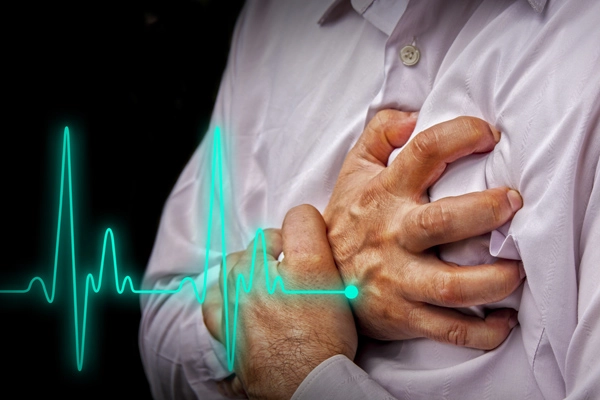Surviving several heart attacks and A-fib


Gregg B. lived with heart problems for nearly 20 years. He experienced his first heart attack at 40 years old, his second at 50 and recently at 59 two more following a stroke.
After each heart attack, Gregg was taken to the Salem Health West Valley ER. According to his wife Janet, he had phenomenal care while in the ER, and each time the ER team was able to stabilize Gregg before transferring him to Salem Health. “They even brought him back to life once from full cardiac arrest.”
Prior to Gregg’s stroke, he experienced atrial fibrillation (A-fib). A-fib is an irregular heartbeat or cardiac arrhythmia. People can live with A-fib without any other problems. However, the likelihood of a stroke occurring in people with A-fib is significantly higher than in the general population.
With A-fib, the rapid and irregular beating slows the flow of blood through the atria. This can make the blood more likely to clot, get pumped out of the heart and into the brain, causing a stroke.
Two days after experiencing A-fib, Gregg had a stroke. So, as soon as he had recovered from the stroke, Gregg went in for cardiac ablation in an effort to prevent another stroke.
Catheters with electrodes on the tips were inserted through his blood vessels to reach his heart. Matthew Fedor, MD, destroyed the abnormal heart tissue causing the irregular heart rhythm.
Gregg’s ablation was successful. However, while recovering at Salem Health, he awoke with a stomach ache. “I had this condition for a while after the stroke,” Gregg said. “It felt like someone was inflating a football in my diaphragm. We thought it was a symptom of the stroke, when it was actually heart failure.”
“I told my wife I didn’t feel good and thought I was having a heart attack,” Gregg said.
She immediately called for help. Gregg was hooked up to an EKG (electrocardiogram) and moved from observation to the Cardiac Intensive Care Unit.
“Then, I was taken to the Cath lab to try to see if I had blockage in one of my arteries,” said Gregg. “That was where my heart stopped. I coded several times.”
Kamran Ghalili, MD and his team gave CPR to Gregg for 45 minutes. “They didn’t think I would make it, but they didn’t give up,” said Gregg. “Without Dr. Ghalili and the rapid response of the team in the Cath lab, I wouldn’t be here today.”
Dr. Ghalili cautioned the family about the seriousness of Gregg’s condition. Gregg was on a balloon pump and respirator to keep him alive. Gregg survived through the weekend.
On Monday, Gregg’s regular cardiologist, James Lowry, MD, said he needed to be weaned from the pump and ventilator, but wasn’t sure if Gregg was strong enough to handle it. He made it.
Gregg was so weak, his doctors couldn’t safely do further tests.
Thomas Winkler, MD, needed to confirm there was blockage to determine if Gregg was a candidate for open heart surgery. “I was still weak, but needed an angiogram to properly evaluate my heart condition,” said Gregg. “The angiogram went well. The following Monday, nine days after my heart attack, Dr. Winkler performed my triple bypass.”
“I was in the hospital for 15 days from beginning to end,” Gregg stated. “As it turns out, I was a ticking time bomb. My physicians said any bit of stress, even a twisted ankle, could have triggered the heart attack.”
According to Gregg, the Salem Health Heart & Vascular Institute doctors and Salem Health nursing staff were unbelievable. “I not only had top rate care, but they were so good to my family,” remembers Gregg. “My family coined the event ‘Occupy Salem Health’ because they lived at the hospital for over two weeks. The staff was so accommodating to all of us. My three kids slept on fold-out beds and recliners in the waiting room that the staff brought for them.”
“Give me Salem Health any day,” said Janet. “We have so much gratitude for the care that Gregg was given at Salem Health. I will never forget how wonderful and warm the staff was in taking care of our entire family.”
Janet said the experience was personal and different from the traditional, taciturn medical treatment. “One of the men from the Cath lab who provided CPR on Gregg came to check on and visit Gregg in his room on more than one occasion.”
Come to find out, one of the nurses who cared for Gregg had been a babysitter for them. When she learned Gregg had survived, she started crying and said, “That is why I am a nurse — to see people that far along survive.”
Gregg completed cardiac rehabilitation. His color was better, and he was stronger. “Cardiac rehab was a positive experience,” said Gregg. “They were really patient with me. I couldn’t do anything with my chest at first, so they put together a good program to keep my legs in shape and slowly integrate my arms. At 6’3” and 270 pounds, I had to use a walker at first and could barely get around.”
Gregg got to the point where he was able to walk the treadmill for 30 minutes and work in his shop — a hobby he is grateful to be alive to enjoy.
Since then, Gregg had a defibrillator implanted to regulate his heart and continues his pursuit of recovery and reconditioning.
According to Janet, “Gregg is embracing each day of his life due to the wonderful care both at Salem Health West Valley Hospital and Salem Health.”